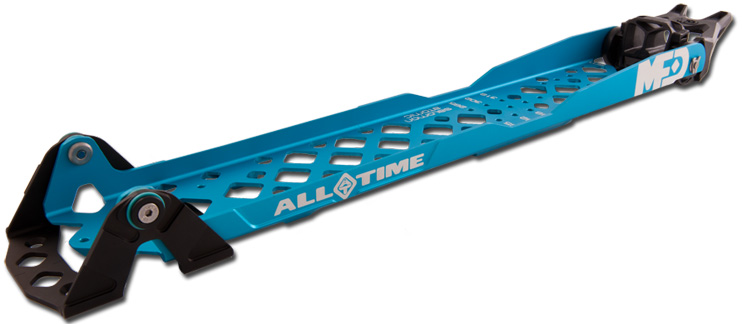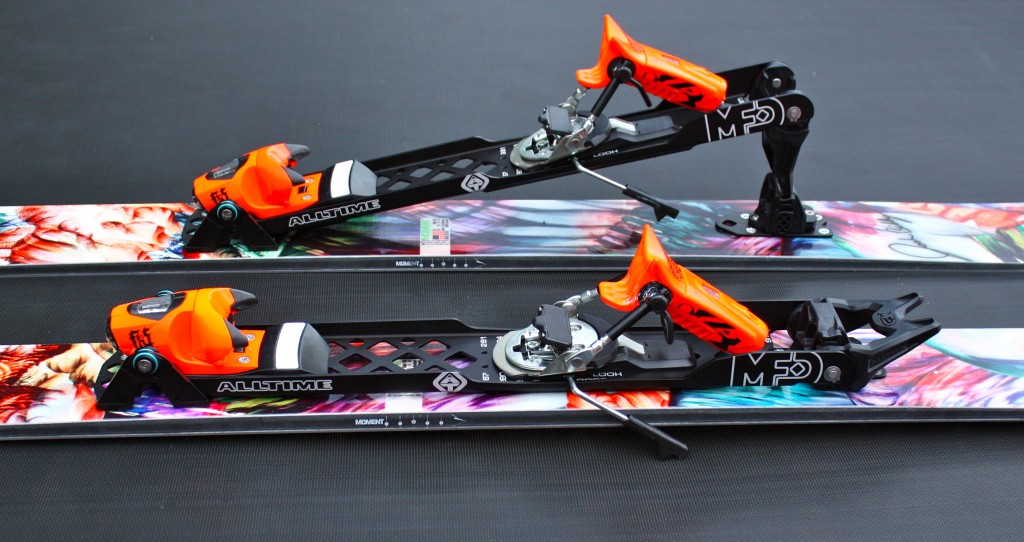The MFD ALLTIME: Trekker Slaughterer, Duke Killer?
A dilemma exists for alpine skiers who want to access the untouched expanses of backcountry terrain but don’t want to sacrifice the performance of a high-DIN alpine binding. Yes, the release of Marker’s Duke and Baron bindings several seasons ago presented an attractive option. Yet for those of us who either can’t drop the cash on a pair; have issues with their notoriously low elasticity; are concerned with weight; or are looking to adapt an existing resort setup for touring, the options are very slim.
Backcountry Access makes the Alpine Trekker, which are adaptors that click into regular alpine bindings, creating a free-heeled platform designed to fit any alpine boot. Granted, depending on your boot size, using them with bindings with a tall heelpiece (most new Marker and Look/Rossignol bindings) may not work so nicely. The heel of your boot will rest on the binding, not on the bottom trekker platform. Regardless of these minor compatibility issues, Trekkers (or “Day-rekkers” as they’ve sometimes been called), can get the job done. I have been on a number of tours using them with only the slightest inconvenience. And yet, given the Trekkers’ heavy weight, bulky construction, lack of torsional rigidity, awkward 3″ stand height, and a build-quality that doesn’t seem to justify the $180 price tag, they make for a less than ideal AT setup. Soon, however, there might be a better way.
MFD Inc., a Salt Lake City based company, has announced their plan to release a new AT binding system to retailers in fall, 2011. The MFD ALLTIME, the company’s flagship product, aims to satisfy alpine skiers looking toward the backcountry while minimizing the drawbacks of an adapter system. A machined aluminum channel with releasable heel is mounted to the ski. From here, almost any high-performance binding from Salomon, Rossignol, Look, Atomic, Marker, 4FRNT, Tyrolia, or Head can be used. The ALLTIME comes in four different models to accommodate different binding mount patterns.

MFD’s design seems to be worlds better than a Trekker setup, and better than Baron or Duke in many respects. Trekkers weigh in at a little over 900g, (that’s 2 lbs per ski) whereas the ALLTIME’s, made from T6 aluminum, are listed at 600g per ski. Paired with an average weight, high-DIN binding like the Salomon STH 14, you’re looking at about 1625g per side using the MFD’s, compared to 1300g a side with the Marker Duke. Using a lightweight performance alpine binding (e.g., the Tyrolia SL100) with the ALLTIME would reduce the weight even further. The weight all depends on the binding you choose, and let’s face it: the crowd looking to buy from MFD won’t be the most weight conscious demographic out there. Durability and function will mean more to these consumers than 600 extra grams of aluminum.
While the ALLTIME setup doesn’t look like it’ll blow away the Duke or Baron in terms of weight, other advantages lie elsewhere. The stack height is lower than any other high DIN AT binding system (certainly lower than the Duke, which puts the boot sole a little more than 1″ above the ski). Perhaps more importantly, the ALLTIME is made with torsionally strong and replaceable bearings. Toe pivot points are notorious for becoming weak and loose over time on nearly all AT bindings. MFD may have created a solution to this. They better have, since most skiers looking to buy the ALLTIME won’t tolerate any kind of slop in the toepiece on their descent.

The riser system on the ALLTIME looks promising. With 6 and 14 degree positions, the riser bar also serves as the locking mechanism for the heel. Apparently, this can all be manipulated easily with just a pole. If that is indeed the case, MFD presents a more efficient design than the Duke or Baron, which requires the ski to be removed to switch in and out of touring mode. The heelpiece of the system (MFD calls it the “Chop Block”) floats on it’s mounting plate that allows the ski to flex naturally. This would be quite a feat for MFD if they can maintain the original performance dynamics of a ski, even with such a large piece of hardware riding on top.
One of the coolest features of the ALLTIME system are MFD’s Switch Plates (available separately). Slap the mounting plates on another pair of skis and you have the ability to move the whole ALLTIME system (with bindings) from one set of boards to another. Why buy another pair of bindings when you only need one? Currently listed at $300 per pair, this could be one of the ALLTIME system’s major selling points.
As intriguing as this new system is, questions still remain. The locking system to go from AT to alpine mode appears to be smooth and effortless. But with the apparent lack of a secondary “safety” latch, what’s to say you won’t find yourself in “instant-tele mode,” making a smooth and effortless face-plant in the middle of your line?

Furthermore, while MFD advertises a highly efficient pivot point on the ALLTIME, it looks to be pretty far forward, which could make for an awkward touring stride. However, a low stack height, a tight pivot point, and room to accommodate the beefy toe-piece of a full alpine binding is nearly impossible from an engineering standpoint. (Hence the design of the short, stubby toe on the Duke and Baron). The question remains, then: will the advantages of a low stack height on the ALLTIME make up for their forward pivot point, or is the system compromised unacceptably from the get-go?
MFD’s ALLTIME system doesn’t look like it will beat a Dynafit or Fritchi setup for longer tours. So while the skier market for the MFD ALLTIME looks to be relatively small, endorsements from Sage Cattabriga-Alosa lend a certain amount of credibility to the product.
As for the $300 price point, small production numbers of high quality equipment come at a price to the buyer, and we may see prices come down if sales take off. To skiers looking for alternative to BCA’s Alpine Trekkers, and perhaps an improvement on Marker’s Duke or Baron, the MFD ALLTIME might just be the answer.
UPDATE:
You can now check out BLISTER’s follow up review of the MFD ALLTIME.

Hey Will, nice review. Are you going to get the chance to demo these? I’m trying to switch out my Duke’s because I Hate having to take my ski off to switch from touring to alpine mode, especially on the steeps. I don’t want to drop the cash for Fritchi or Dynafit so these may be my ticket. I’m a bit hesitant to get on first generation gear so it would be sweet to know what you thought of these after giving them a whirl.
Cheers from one Taos ski bum to another.
Hey Forrest,
Thanks for reading! We’re working on getting a pair of these to test asap, so stay tuned.
You’re absolutely right, not having to take your ski off is a significant advantage over the Duke’s. The ALLTIME may be heavy, but features like that could make it a worthy solution. We’ll see.
Cheers,
WB